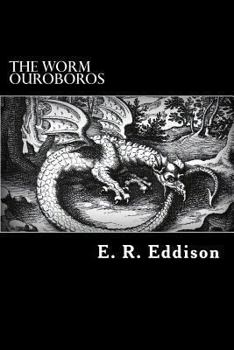Book Overview
The Worm Ouroboros is a heroic high fantasy novel by Eric R cker Eddison, first published in 1922. The book describes the protracted war between the domineering King Gorice of Witchland and the Lords of Demonland in an imaginary world that appears mainly medieval and partly reminiscent of Norse sagas. The work is slightly related to Eddison's later Zimiamvian Trilogy, and collectively they are sometimes referred to as the Zimiamvian series. Eric R...
Format:Paperback
Language:English
ISBN:1482627493
ISBN13:9781482627497
Release Date:February 2013
Publisher:Createspace Independent Publishing Platform
Length:574 Pages
Weight:1.67 lbs.
Dimensions:1.2" x 6.0" x 9.0"
Related Subjects
Betrayal Destiny Friendship Love Magic Mythical Creatures Politics Warfare Power Struggles ClassicsCustomer Reviews
2 ratings
A Giant among Giants
Published by Thriftbooks.com User , 19 years ago
Some books are optional. "The Worm Ouroboros", by E. R. Eddison, is not. It is more than just the birth of high fantasy writing as we know it. It is a tale that connects with imagination and wonder in a way that books today simply don't do. When you read "The Worm Ouroboros" you'll realize that modern writers produce stories, but they don't tell Stories. Since the English language fails to provide me with adequate superlatives for this review, I'll just have to present samples of Eddison's writing: "But a great wonder of this chamber, and a marvel to behold, was how the capital of every one of the four-and-twenty pillars was hewn from a single precious stone, carved by the hand of some sculptor of long ago into the living form of a monster: here was a harpy with a screaming mouth, so wonderously cut in ochre-tinted jade it was a marvel to hear no scream from her: here in wine-yellow topaz a flying fire-drake: there a cockatrice made of a single ruby: there a star sapphire the colour of moonlight, cut for a cyclops, so that the rays of the star trembled from his single eye: leviathans, all hewn from faultless gems, thrice the bulk of a big man's body, velvet-dark sapphires, crystolite, beryl, amethyst, and the yellow zircon that is like transparent gold." (7) Everyone can write description, but only Eddison could write description like this. He makes the colors shine brighter and the shapes of the "monsters" stick out in your mind. And even though you may not know what a crystolite looks like, you agree that it fits perfectly into this paragraph. Eddison realized that you can't a world that mirrors the heroic past if you get stuck in the decidedly un-heroic language of modern times. "Now had they for three days or four a devious journey through the foot-hills, and thereafter made their dwelling for forty days' space in the Zia valley, above the gorges. Here the valley widens to a flat-floored amphitheatre, and lean limestone crags tower heavenward on every side. High in the south , couched above great gray moraines, the Zia glacier, wrinkle-backed like some dragon survived out of the elder chaos, thrusts his snout into the valley. Here out of his caves of ice the young river thunders, casting up a spray where rainbows hover in bright weather. The air blows sharp from the glacier, and alpine flowers and shrubs feed on the sunlight." (153) Perhaps it's because I'm a mountain-climber myself, but I found Juss and Brandoch Daha's assault on Koshtra Pivrarcha to be the most memorable chapter in a book built out of unforgettable chapters. In real life no two mountain ranges are alike, yet most fantasy authors write only staid standard-issue descriptions when they make mountains. Eddison understood that for us to see the glaciers, feel the biting cold winds, and experience the exhilaration of reaching the summit with the heroes, he needs to give his mountains some real personality. These samples, of course, only scratch the surface of E
Beauty at the heart of the world
Published by Thriftbooks.com User , 22 years ago
As a youngster I devoured fantasy greedily, any fantasy (there was not a fantasy-genre industry in those days, and fantasy was hard to come by.) Much of what I liked then I can no longer read: too much bombast and adolescent wish-fulfilment But Eddison improves with each rereading.His prose is beautiful, as everyone remarks. If you don't have the patience for sentences of more than two clauses, or if you have a prim horror of archaic language, you should skip this book. (Or maybe you should re-examine the rewards of patience: but that's another matter). But if you have the capacity to appreciate beautiful English prose, if you can read Sir Thomas Browne or the King James Bible with pleasure, then you have a treat in store. Read this book: there aren't many like it.There's a serious philosophy in this book. Eddison believes in greatness. It's no accident that his literary antecedents are in classical Greece and Iceland: Alkibiades and Grettir would have understood his devotion to the heroic, to the ferocious, doomed attempt to set one's indelible mark on the stream of time. For Eddison the reckless, whole-hearted, passionate life is the only life worth living, and the only life worth writing about.It's not a philosophy I agree with. It lives too close to fascism and machismo for me: it insists upon and glorifies a sense of Self that I think is ultimately nonsense. But it's a philosophy that produced much of the most beautiful literature of the last century: Ezra Pound and William Butler Yeats often wrote from just this standpoint. It may be wrong, but it's not childish. It situates Beauty at the heart of the world: greatness, to Eddison, is beautiful action, and all beautiful things demand worship. And reward it. "What I have promised," says Eddison's Aphrodite, "I will perform."Read this book. Read Mistress of Mistresses too. They're dazzling, magnificent books.





